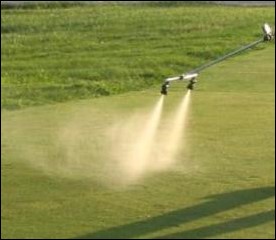Nozzles and water quality? Does that make you yawn?
Let’s start with nozzles
Spray nozzles might seem like a boring topic, but as stated in an article by Shepard, Agnew, Fidanza, Kaminski, and Dant in 2006 in Golf Course Management, nozzles are “The last piece of equipment through which sprays pass before contact with the turf.”
Think about the cost of all that stuff going through the sprayer, the time of the person applying those materials, and the fuel to power that sprayer (unless it’s a hand-sprayer, in which case I guess you count the cost of the donuts to feed that person walking around). Nozzles are small, and they don’t cost much, but they can really contribute to the success of an application and help maximize the bang for your buck on all those OTHER costs.
(Gee… I really need a donut!)
Anyway – as noted in the article cited above, nozzles determine the amount of chemical applied, the uniformity of the application, the coverage, and they can influence the risk of drift. Make sure you calibrate your equipment, replace worn nozzles, and follow all label instructions about application equipment for the materials you are spraying. A worn-out nozzle could easily be allowing 10% or more excess material to be applied, which = 10% more money. Equipment that is not calibrated right might be applying LESS than you need to get adequate control.
Okay – now onto water quality.
Water quality? Snooze?
I just said that nozzles are the last thing to touch the materials before it goes soaring through the air and smacks into the plant. Water? That’s the stuff that cozies up with the product as soon as it hits the tank and stays with it the whole way.
Pop quiz – Which of these can affect pesticide performance?
- Water pH
- Water hardness
- Dissolved minerals
- Suspended solids
Or – you guessed it – all of the above.
Do you know what the pH of your water is? When is the last time you tested it?
There is an excellent publication on The Impacts of Water Quality on Pesticide Performance from Purdue. It is an easy read that discusses these factors with some pointers about testing. For example, pH can be testing using easy at-home test strips.
Be sure to follow all label instructions about water quality. Some pesticides are very sensitive to high pH, for example.
Don’t forget about some of those basic nuts and bolts, like nozzles, calibration, and water. If you don’t test them out now and then, there could be problems lurking that you don’t know about.



